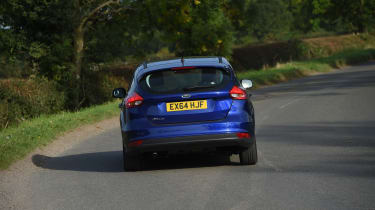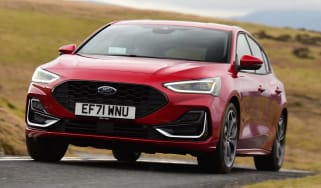Used Ford Focus review: 2011 to 2018 (Mk3) - Engines, performance and drive
The Ford Focus is one of the most enjoyable and comfortable cars in its class; it’s the car’s most impressive aspect
If you want a hatchback that’s fun to drive, look no further than the Ford Focus. While this third-generation model isn’t quite as sharp as the fantastic Mk1 model, it’s still the best-handling car in its class and all models feel lively in corners. This is thanks to responsive controls, including sharp steering and positive gear shifts.
As part of the 2014 facelift, Ford improved the Focus’ steering and tweaked the suspension slightly to help improve cornering agility. They were subtle changes, but they cemented the Focus as the car to pick in this class for those who enjoy driving.
What is the Ford Focus like to drive?
The Focus has pleasant steering, lots of grip and a great driving position, so it’s very satisfying on a twisty road. It feels sportier than a Skoda Octavia or VW Golf, and even the most basic Focus models are more fun to drive than some sporty hot hatchbacks if you don’t mind the lower performance.
The Focus doesn’t sacrifice comfort, though, as it’s also really good over bumpy roads and potholes. The driving position also helps with long-distance trips as you’ll stay in a comfy position. The seats are soft but provide enough support to keep you in place when going round bends.
More reviews
We’ve found that versions on bigger wheels can feel rather less manoeuvrable at parking speeds than cars with smaller wheels. It’s worth checking that you’re happy with the steering on any Focus you test drive.
In town, the Focus is relatively comfortable, although the larger 17- and 18-inch alloy wheels also reduce comfort slightly, transmitting the sharpest bumps inside. On the motorway, cars with six-speed gearboxes are quiet, but five-speed models are less so (but only the entry-level 1.6 and 1.0-litre EcoBoost petrol engines become noticeably noisy).
Which engine should I choose?
The engine range complements the entertaining handling, with decent performance from every option apart from the sluggish entry-level 1.6-litre petrol with its meagre 83bhp.
Particular highlights include the 123bhp version of the 1.0-litre EcoBoost turbo petrol, which feels powerful and responsive for such a small engine. A 0-62mph time of 11.2 seconds and top speed of 120mph aren’t anything to write home about, but there’s decent mid-range power for overtaking.
If you’re buying the ST-Line model because you want some of the performance of the ST but without the price tag and running costs, the 1.5-litre EcoBoost is your best bet – the 179bhp version manages 0-62mph in 8.8 seconds. A diesel engine is available, too, but the powerful petrol is our favourite model in the range and will be the best bet for the most amount of people.
The range of diesel engines available in the Focus range is just as comprehensive as the petrol line-up. The 1.5-litre TDCi diesels – with 94, 104 or 118bhp outputs – as well as two 2.0-litre TDCi diesels are punchy and economical. There's a 148bhp version that's available in standard models, plus a 182bhp version reserved for the Focus ST diesel.
All the diesels feel strong and reasonably quick, even the 94bhp version. The 148bhp 2.0-litre TDCi has all the power you could want from a car of this size. It also feels stronger than the equivalent Volkswagen Golf fitted with a 2.0-litre TDI engine, responding more urgently when you put your foot down.
In the older models, the 1.6-litre turbo petrol model is good for all-round use, or choose the 1.6-litre diesel if you are doing a lot of motorway trips as it’s really economical. It’s a bit noisy, though.
The Focus ST and RS models have unique engines only available in this sporty format – they’re 2.0-litre and 2.3-litre units respectively. The RS has incredible performance and can get from 0-62mph in less than five seconds.














